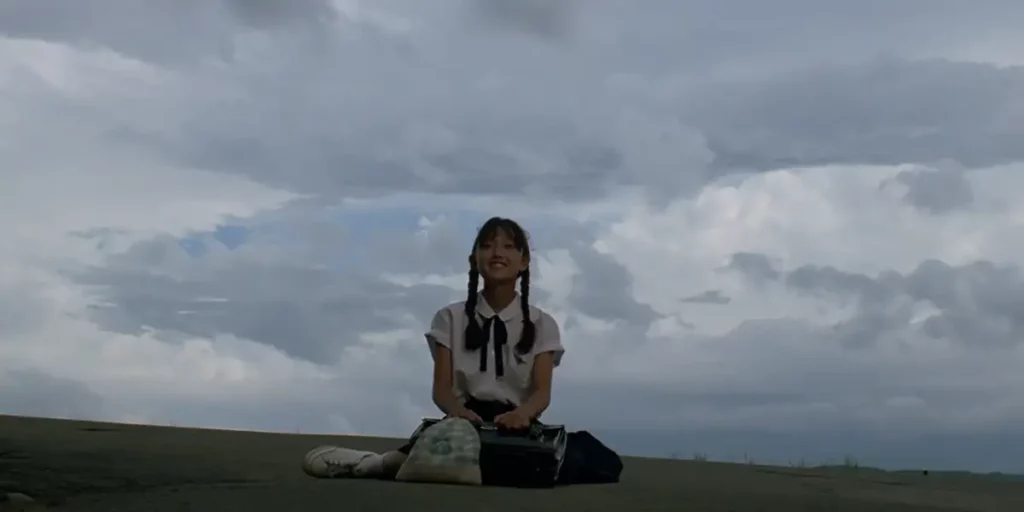Shinji Sōmai’s Typhoon Club is not just a film about young people, but an exploration into what it means to be young, and the innocence that comes with that.
Director: Shinji Sōmai
Genre: Drama, Coming of Age
Run Time: 115′
Original Release: December 1986
Restoration Release: August 2024
Where to watch: at the Metrograph (NY)
If I may be honest for a second, I think there are elements of Shinji Sōmai’s Typhoon Club (1985) that I have yet to fully comprehend. I mean that in an incredibly positive way, as it’s obviously a film with a lot on its mind. Sōmai is obviously fascinated with the idea of youth, the inherent innocence that teenagers are blessed with and how that contrasts with the more horrific sides of the human psyche.
At times, the film almost feels like a bizarre enigma, but the way I see it, that surrealism is the result of Sōmai attempting to tap into the mind of a teenager. He shows us scenes that are simply just kids dancing. On the surface, it’s cute and somewhat quirky. Then, it hits you. These kids are dancing in the face of danger, embracing their naivety and blissful ignorance in the literal centre of a typhoon, unaware of the horror that surrounds them. In Sōmai’s eyes, embracing the innocence of your youth means rejecting the future and all the terrifying baggage that comes with it.
If you were just to hear the film’s premise, you might think that Typhoon Club is the same kind of coming-of-age comedy as, say, John Hughes’ The Breakfast Club, coincidentally released in the same year. The narrative follows a group of six junior high students who find themselves stuck in their school when a typhoon hits their local area. Immediately, this sounds like a premise ripe for comedy, romance and some quality bonding. That would be the easy way to write this film, but Sōmai instead takes the plot in a very different direction. He’s far less concerned with the bond between our characters, and instead more interested in the bigger question of what it means to be young.
The young mind is, honestly, quite a terrifying thing. A lack of experience can result in a fuzzy understanding of the world, and that sees us make mistake after mistake. Ultimately, this is how we learn to safely navigate this planet, but in Typhoon Club, Sōmai pushes this instinct to its natural extreme. Locked away, without the fear of consequences, his characters commit some truly horrible acts. Typhoon Club features some incredibly uncomfortable moments, and Sōmai’s camera isn’t afraid to show us the worst of what humanity can be. At times, the film’s bleak tone and unwavering eye makes it come across like a horror, and there are multiple scenes that wouldn’t feel at all out of place in a movie like that.
It’s the school setting that makes these actions even more horrifying. The innocence of school-children and the aura of safety that a school is meant to provide is contrasted with some of the worst things that humans can do. Typhoon Club is an inherently shocking film, but not necessarily in a way that feels cheap. This type of filmmaking won’t work for everyone, but if there’s one thing for sure, it’s guaranteed to at least get a reaction out of you. What makes it all even more striking is what the shocking scenes are surrounded by, namely moments that highlight the more blissful, joyful aspects of youth.
Dancing in the rain in only your underwear, philosophical chats about life: these are the moments that Sōmai uses to show us the other extreme of the teenage psyche. The part of us that stares danger in the eye, in this case quite literally, and embraces it as yet another experience to help shape our lives. There’s something truly beautiful in that image of them dancing in the eye of the typhoon, their mind not worrying about any potential consequences, only embracing what feels like a once-in-a-lifetime moment.
As we get older, we naturally get more cynical. We chase after maturity, and in an attempt to feel adult, we start to regard the enjoyment of things as cringe-worthy. In a race to grow up, we leave behind that pure desire to be ourselves, let loose and have fun. As adults, we only seem to dance when we’re intoxicated, when we feel like it’s socially acceptable to let loose. As kids, we danced simply because we wanted to. We didn’t need a reason, or anyone to give us permission. We just danced, because we could.
Not everything the Typhoon Club attempts to do works. I can’t really blame it on that front, as it’s an incredibly complicated film that is trying to balance multiple, heavily contrasting tones, but there’s definitely an air of inconsistency to it throughout its runtime. With that being said, though, it’s rare to see a coming-of-age film this assured and with this much to say. Sōmai explores what it means to be young, placing his characters in dangerous situations in order to push their psyche to their extremes. It’s a bold film with a lot to say, and whilst its slow, shocking nature may not work for everyone, I’m sure I’m not going to be able to stop thinking about it anytime soon.
The new 4K Restoration of Typhoon Club is being screened at the Metrograph (NY), as part of their “Shinji Sōmai x 3” retrospective.

